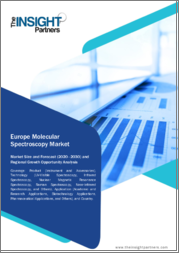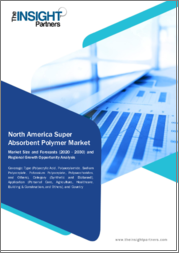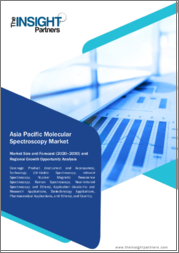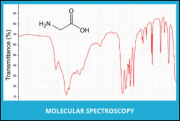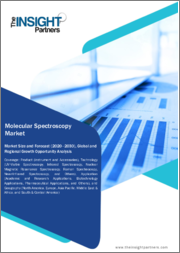
|
시장보고서
상품코드
1609089
세계의 분자분광법 시장 : 기술별, 용도별 예측(2025-2030년)Molecular Spectroscopy Market by Technology, Application - Global Forecast 2025-2030 |
||||||
분자분광법 시장은 2023년에 73억 9,000만 달러로 평가되었고, 2024년에는 77억 7,000만 달러에 이를 것으로 예측되며, CAGR 5.37%로 성장하여 2030년에는 106억 6,000만 달러에 달할 것으로 예상됩니다.
분자분광법은 과학연구나 산업에 있어서 다양한 에너지 형태와의 상호작용에 의해 분자를 동정·정량하기 위한 중요한 분석 툴입니다. 분석을 위한 석유화학, 품질관리를 위한 식품과 농업, 오염 모니터링을 위한 환경과학 등 폭넓은 분야에서의 응용에서 발생하고 있습니다. 까지 퍼지고 있습니다. 주요 성장 요인은 휴대용 소형화된 분광계와 같은 기술적 진보와 신속하고 비파괴적인 분석 기술에 대한 수요 증가를 포함합니다. 통합도 데이터 분석 능력을 강화하고 시장 확대 잠재적인 기회는 고급 분자분석을 필요로하는 개인화된 의료의 성장과 함께 제약 및 농업 분야가 급성장하는 신흥 시장으로의 진출을 포함합니다. 권장사항으로는 혁신적 분광 기술의 연구 개발에 투자하고 AI 통합을 위한 하이테크 기업과의 제휴를 들 수 있습니다. 가용성을 제한하는 규제 장애물이 시장 성장의 과제가 되고 있습니다. 또한, 새로운 분광법에서는 표준화와 교정의 필요성이 높아져, 이것이 폭넓은 수용의 방해가 될 가능성이 있습니다. 비용 효율적인 장비 개발, 실시간 분석 기술의 진보, 저자원 환경에서의 적용 범위 확대 등을 들 수 있습니다. 이러한 동향을 선도하고, 분야 횡단적인 용도을 위한 파트너십을 키우고, 증가하는 세계 수요에 대응하기 위해 지속 가능하고 확장 가능한 솔루션을 우선함으로써 경쟁력을 높일 수 있습니다.
| 주요 시장 통계 | |
|---|---|
| 기준년(2023) | 73억 9,000만 달러 |
| 추정년(2024) | 77억 7,000만 달러 |
| 예측년(2030) | 106억 6,000만 달러 |
| CAGR(%) | 5.37% |
시장 역학: 급속히 진화하는 분자분광법 시장의 주요 시장 인사이트 공개
분자분광법 시장은 수요 및 공급의 역동적인 상호작용에 의해 변모를 이루고 있습니다. 새로운 비즈니스 기회를 획득할 수 있습니다. 이러한 동향을 종합적으로 파악함으로써 기업은 정치적, 지리적, 기술적, 사회적, 경제적 영역에 걸친 다양한 리스크를 경감할 수 있을 뿐만 아니라 소비자 행동과 그것이 제조 비용 또는 구매 동향에 미치는 영향을보다 명확하게 이해할 수 있습니다.
- 시장 성장 촉진요인
- 바이오테크놀러지 및 제약 기업에서의 채용 확대
- 식품의 품질 확보에 대한 관심 증가
- 환경 스크리닝 용도 수요 급증
- 시장 성장 억제요인
- 자본 집약적인 설비와 시스템의 유지보수
- 시장 기회
- 분자분광법 시스템의 효율과 화질을 향상시키는 기술의 진보
- 헬스케어에 있어서의 테라헤르츠 분광법의 새로운 채용
- 시장의 과제
- 고도로 숙련된 전문가의 부족
Porter's Five Force : 분자분광법 시장을 탐색하는 전략 도구
Porter's Five Force Framework는 시장 상황경쟁 구도를 이해하는 중요한 도구입니다. Porter's Five Force Framework는 기업의 경쟁력을 평가하고 전략적 기회를 탐구하는 명확한 기술을 제공합니다. 이 프레임워크는 기업이 시장 내 세력도를 평가하고 신규 사업의 수익성을 결정하는 데 도움이 됩니다. 이러한 통찰을 통해 기업은 자사의 강점을 활용하고, 약점을 해결하고, 잠재적인 과제를 피할 수 있으며, 보다 강인한 시장에서의 포지셔닝을 보장할 수 있습니다.
PESTLE 분석 : 분자분광법 시장에서 외부로부터의 영향 파악
외부 거시 환경 요인은 분자분광법 시장의 성과 역학을 형성하는데 매우 중요한 역할을 합니다. 정치적, 경제적, 사회적, 기술적, 법적, 환경적 요인 분석은 이러한 영향을 탐색하는 데 필요한 정보를 제공합니다. PESTLE 요인을 조사함으로써 기업은 잠재적인 위험과 기회를 더 잘 이해할 수 있습니다. 이 분석을 통해 기업은 규제, 소비자 선호, 경제 동향의 변화를 예측하고 앞으로 예상되는 적극적인 의사 결정을 할 준비를 할 수 있습니다.
시장 점유율 분석 : 분자분광법 시장 경쟁 구도 파악
분자분광법 시장의 상세한 시장 점유율 분석을 통해 공급업체의 성과를 종합적으로 평가할 수 있습니다. 기업은 수익, 고객 기반, 성장률 등 주요 지표를 비교하여 경쟁 포지셔닝을 밝힐 수 있습니다. 이 분석을 통해 시장 집중, 단편화, 통합 동향을 밝혀내고 벤더들은 경쟁이 치열해지는 가운데 자사의 지위를 높이는 전략적 의사 결정을 내리는 데 필요한 지식을 얻을 수 있습니다.
FPNV 포지셔닝 매트릭스 : 분자분광법 시장에서 공급업체의 성능 평가
FPNV 포지셔닝 매트릭스는 분자분광법 시장에서 벤더를 평가하는 중요한 도구입니다. 네 가지 사분면을 통해 벤더를 명확하고 정확하게 분할하고 전략 목표에 가장 적합한 파트너 및 솔루션을 파악할 수 있습니다.
전략분석과 권장 : 분자분광법 시장에서 성공을 위한 길을 그리기
분자분광법 시장의 전략분석은 세계 시장에서의 프레즌스 강화를 목표로 하는 기업에 필수적입니다. 이 접근법을 통해 경쟁 구도에서 과제를 극복하고 새로운 비즈니스 기회를 활용하여 장기적인 성공을 거둘 수 있는 시스템을 구축할 수 있습니다.
이 보고서는 주요 관심 분야를 포괄하는 시장의 종합적인 분석을 제공합니다.
1. 시장 침투: 현재 시장 환경의 상세한 검토, 주요 기업의 광범위한 데이터, 시장 도달범위 및 전반적인 영향력 평가.
2. 시장 개척도: 신흥 시장의 성장 기회를 파악하고 기존 분야의 확장 가능성을 평가하며 미래 성장을 위한 전략적 로드맵을 제공합니다.
3. 시장 다양화: 최근 제품 출시, 미개척 지역, 업계의 주요 진보, 시장을 형성하는 전략적 투자를 분석합니다.
4. 경쟁 평가 및 정보 : 경쟁 구도를 철저히 분석하여 시장 점유율, 사업 전략, 제품 포트폴리오, 인증, 규제 당국 승인, 특허 동향, 주요 기업의 기술 진보 등을 검증합니다.
5. 제품 개발 및 혁신 : 미래 시장 성장을 가속할 것으로 예상되는 최첨단 기술, R&D 활동, 제품 혁신을 강조합니다.
또한 이해관계자가 충분한 정보를 얻고 의사결정을 할 수 있도록 중요한 질문에 대답하고 있습니다.
1. 현재 시장 규모와 향후 성장 예측은?
2. 최고의 투자 기회를 제공하는 제품, 부문 및 지역은 어디입니까?
3. 시장을 형성하는 주요 기술 동향과 규제의 영향은?
4. 주요 벤더의 시장 점유율과 경쟁 포지션은?
5. 벤더 시장 진입·철수 전략의 원동력이 되는 수익원과 전략적 기회는 무엇인가?
목차
제1장 서문
제2장 조사 방법
제3장 주요 요약
제4장 시장 개요
제5장 시장 인사이트
- 시장 역학
- 성장 촉진요인
- 바이오테크놀러지 기업이나 제약 기업에서의 채용이 증가
- 식품의 품질 확보에 대한 관심 증가
- 환경 스크리닝 용도 수요 급증
- 억제요인
- 자본 집약적인 설비와 시스템의 메인터넌스
- 기회
- 분자분광법 시스템의 효율과 화질을 향상시키는 기술의 진보
- 헬스케어에 있어서의 테라헤르츠 분광법의 새로운 도입
- 과제
- 고도의 스킬을 가진 전문가의 부족
- 성장 촉진요인
- 시장 세분화 분석
- Porter's Five Forces 분석
- PESTEL 분석
- 정치적
- 경제
- 사교
- 기술적
- 법률상
- 환경
제6장 분자분광법 시장 : 기술별
- 색 측정 분광법
- 적외선 분광법
- 근적외 분광법
- 필터 NIR 분광법 또는 음향 광학 가변 필터 NIR 분광법
- 푸리에 변환 근적외선 분광법
- 주사형 근적외 분광법
- 핵자기 공명 분광법
- 연속파 NMR 분광법
- 푸리에 변환 NMR 분광법
- 고체 NMR 분광법
- 라만 분광법
- 자외선 가시광선 분광법
- 어레이 기반 UV-가시 분광법
- 듀얼 빔 UV-가시 분광법
- 싱글 빔 UV 가시 분광법
제7장 분자분광법 시장 : 용도별
- 학술연구
- 바이오테크놀러지 및 바이오의약품의 응용
- 환경시험
- 식음료의 검사
- 의약품에의 응용
제8장 아메리카의 분자분광법 시장
- 아르헨티나
- 브라질
- 캐나다
- 멕시코
- 미국
제9장 아시아태평양의 분자분광법 시장
- 호주
- 중국
- 인도
- 인도네시아
- 일본
- 말레이시아
- 필리핀
- 싱가포르
- 한국
- 대만
- 태국
- 베트남
제10장 유럽·중동 및 아프리카의 분자분광법 시장
- 덴마크
- 이집트
- 핀란드
- 프랑스
- 독일
- 이스라엘
- 이탈리아
- 네덜란드
- 나이지리아
- 노르웨이
- 폴란드
- 카타르
- 러시아
- 사우디아라비아
- 남아프리카
- 스페인
- 스웨덴
- 스위스
- 터키
- 아랍에미리트(UAE)
- 영국
제11장 경쟁 구도
- 시장 점유율 분석 2023
- FPNV 포지셔닝 매트릭스, 2023
- 경쟁 시나리오 분석
- 전략 분석과 제안
기업 목록
- ABB Ltd.
- Agilent Technologies, Inc.
- Block Engineering
- Bruker Corporation
- Carl Zeiss AG
- Danaher Corporation
- Endress Hauser Group Services AG
- Galaxy Scientific Inc.
- Horiba, Ltd.
- Jasco International Co., Ltd.
- Merck KGaA
- PerkinElmer Inc.
- Raptor Photonics Limited
- Shimadzu Corporation
- Siemens AG
- Thermo Fisher Scientific Inc.
The Molecular Spectroscopy Market was valued at USD 7.39 billion in 2023, expected to reach USD 7.77 billion in 2024, and is projected to grow at a CAGR of 5.37%, to USD 10.66 billion by 2030.
Molecular spectroscopy is a critical analytical tool in scientific research and industry for identifying and quantifying molecules by their interaction with various energy forms. The necessity of molecular spectroscopy arises from its extensive application across sectors, including pharmaceuticals for drug development, petrochemicals for resource analysis, food and agriculture for quality control, and environmental science for pollution monitoring. The end-use scope extends to academic institutions, government research laboratories, and private industries seeking advanced analytical capabilities. Market insights reveal that key growth factors include technological advancements, such as portable and miniaturized spectrometers, and increasing demand for rapid, non-destructive analytical techniques. Developments in software and integration with artificial intelligence are also enhancing data analysis capabilities, driving market expansion. Potential opportunities include expanding into emerging markets with burgeoning pharmaceutical and agricultural sectors, alongside growth in personalized medicine requiring sophisticated molecular analysis. Recommendations to capture these opportunities involve investing in R&D for innovative spectroscopic technologies and collaborations with tech companies for AI integration. However, market growth is challenged by high equipment costs, complex operation requiring skilled personnel, and regulatory hurdles limiting ease of adoption in certain sectors. Additionally, there is a growing need for standardization and calibration in emerging spectroscopic methods, which can hinder broad acceptance. Areas ripe for innovation include the development of more user-friendly, cost-effective equipment, advancements in real-time analysis technologies, and broadened applicability in low-resource settings. The nature of the market is highly dynamic, driven by continuous technological breakthroughs and shifts in regulatory landscapes, with a strong focus on connectivity and automation. Companies can gain a competitive edge by staying ahead of these trends, fostering partnerships for cross-sector applications, and prioritizing sustainable, scalable solutions to meet increasing global demand.
| KEY MARKET STATISTICS | |
|---|---|
| Base Year [2023] | USD 7.39 billion |
| Estimated Year [2024] | USD 7.77 billion |
| Forecast Year [2030] | USD 10.66 billion |
| CAGR (%) | 5.37% |
Market Dynamics: Unveiling Key Market Insights in the Rapidly Evolving Molecular Spectroscopy Market
The Molecular Spectroscopy Market is undergoing transformative changes driven by a dynamic interplay of supply and demand factors. Understanding these evolving market dynamics prepares business organizations to make informed investment decisions, refine strategic decisions, and seize new opportunities. By gaining a comprehensive view of these trends, business organizations can mitigate various risks across political, geographic, technical, social, and economic domains while also gaining a clearer understanding of consumer behavior and its impact on manufacturing costs and purchasing trends.
- Market Drivers
- Growing adoption in biotechnology and pharmaceutical companies
- Increasing penchant to ensure the quality of food products
- Surge in demand for environmental screening application
- Market Restraints
- Capital intensive equipment and maintenance of the system
- Market Opportunities
- Advancements in technology to improve the efficiency and image quality of molecular spectroscopy systems
- Emerging adoption of terahertz spectroscopy in healthcare
- Market Challenges
- Dearth of highly skilled professionals
Porter's Five Forces: A Strategic Tool for Navigating the Molecular Spectroscopy Market
Porter's five forces framework is a critical tool for understanding the competitive landscape of the Molecular Spectroscopy Market. It offers business organizations with a clear methodology for evaluating their competitive positioning and exploring strategic opportunities. This framework helps businesses assess the power dynamics within the market and determine the profitability of new ventures. With these insights, business organizations can leverage their strengths, address weaknesses, and avoid potential challenges, ensuring a more resilient market positioning.
PESTLE Analysis: Navigating External Influences in the Molecular Spectroscopy Market
External macro-environmental factors play a pivotal role in shaping the performance dynamics of the Molecular Spectroscopy Market. Political, Economic, Social, Technological, Legal, and Environmental factors analysis provides the necessary information to navigate these influences. By examining PESTLE factors, businesses can better understand potential risks and opportunities. This analysis enables business organizations to anticipate changes in regulations, consumer preferences, and economic trends, ensuring they are prepared to make proactive, forward-thinking decisions.
Market Share Analysis: Understanding the Competitive Landscape in the Molecular Spectroscopy Market
A detailed market share analysis in the Molecular Spectroscopy Market provides a comprehensive assessment of vendors' performance. Companies can identify their competitive positioning by comparing key metrics, including revenue, customer base, and growth rates. This analysis highlights market concentration, fragmentation, and trends in consolidation, offering vendors the insights required to make strategic decisions that enhance their position in an increasingly competitive landscape.
FPNV Positioning Matrix: Evaluating Vendors' Performance in the Molecular Spectroscopy Market
The Forefront, Pathfinder, Niche, Vital (FPNV) Positioning Matrix is a critical tool for evaluating vendors within the Molecular Spectroscopy Market. This matrix enables business organizations to make well-informed decisions that align with their goals by assessing vendors based on their business strategy and product satisfaction. The four quadrants provide a clear and precise segmentation of vendors, helping users identify the right partners and solutions that best fit their strategic objectives.
Strategy Analysis & Recommendation: Charting a Path to Success in the Molecular Spectroscopy Market
A strategic analysis of the Molecular Spectroscopy Market is essential for businesses looking to strengthen their global market presence. By reviewing key resources, capabilities, and performance indicators, business organizations can identify growth opportunities and work toward improvement. This approach helps businesses navigate challenges in the competitive landscape and ensures they are well-positioned to capitalize on newer opportunities and drive long-term success.
Key Company Profiles
The report delves into recent significant developments in the Molecular Spectroscopy Market, highlighting leading vendors and their innovative profiles. These include ABB Ltd., Agilent Technologies, Inc., Block Engineering, Bruker Corporation, Carl Zeiss AG, Danaher Corporation, Endress+Hauser Group Services AG, Galaxy Scientific Inc., Horiba, Ltd., Jasco International Co., Ltd., Merck KGaA, PerkinElmer Inc., Raptor Photonics Limited, Shimadzu Corporation, Siemens AG, and Thermo Fisher Scientific Inc..
Market Segmentation & Coverage
This research report categorizes the Molecular Spectroscopy Market to forecast the revenues and analyze trends in each of the following sub-markets:
- Based on Technology, market is studied across Color Measurement Spectroscopy, Infrared Spectroscopy, Near-Infrared Spectroscopy, Nuclear Magnetic Resonance Spectroscopy, Raman Spectroscopy, and UV-Visible Spectroscopy. The Near-Infrared Spectroscopy is further studied across Filter NIR Spectroscopy or Acoustic-Optical Tunable Filter-NIR Spectroscopy, Fourier-Transform Near-Infrared Spectroscopy, and Scanning Near-Infrared Spectroscopy. The Nuclear Magnetic Resonance Spectroscopy is further studied across Continuous-Wave NMR Spectroscopy, Fourier-Transform NMR Spectroscopy, and Solid-State NMR Spectroscopy. The UV-Visible Spectroscopy is further studied across Array-Based UV-Visible Spectroscopy, Dual-Beam UV-Visible Spectroscopy, and Single-Beam UV-Visible Spectroscopy.
- Based on Application, market is studied across Academic Research, Biotechnology & Biopharmaceutical Applications, Environmental Testing, Food & Beverage Testing, and Pharmaceutical Applications.
- Based on Region, market is studied across Americas, Asia-Pacific, and Europe, Middle East & Africa. The Americas is further studied across Argentina, Brazil, Canada, Mexico, and United States. The United States is further studied across California, Florida, Illinois, New York, Ohio, Pennsylvania, and Texas. The Asia-Pacific is further studied across Australia, China, India, Indonesia, Japan, Malaysia, Philippines, Singapore, South Korea, Taiwan, Thailand, and Vietnam. The Europe, Middle East & Africa is further studied across Denmark, Egypt, Finland, France, Germany, Israel, Italy, Netherlands, Nigeria, Norway, Poland, Qatar, Russia, Saudi Arabia, South Africa, Spain, Sweden, Switzerland, Turkey, United Arab Emirates, and United Kingdom.
The report offers a comprehensive analysis of the market, covering key focus areas:
1. Market Penetration: A detailed review of the current market environment, including extensive data from top industry players, evaluating their market reach and overall influence.
2. Market Development: Identifies growth opportunities in emerging markets and assesses expansion potential in established sectors, providing a strategic roadmap for future growth.
3. Market Diversification: Analyzes recent product launches, untapped geographic regions, major industry advancements, and strategic investments reshaping the market.
4. Competitive Assessment & Intelligence: Provides a thorough analysis of the competitive landscape, examining market share, business strategies, product portfolios, certifications, regulatory approvals, patent trends, and technological advancements of key players.
5. Product Development & Innovation: Highlights cutting-edge technologies, R&D activities, and product innovations expected to drive future market growth.
The report also answers critical questions to aid stakeholders in making informed decisions:
1. What is the current market size, and what is the forecasted growth?
2. Which products, segments, and regions offer the best investment opportunities?
3. What are the key technology trends and regulatory influences shaping the market?
4. How do leading vendors rank in terms of market share and competitive positioning?
5. What revenue sources and strategic opportunities drive vendors' market entry or exit strategies?
Table of Contents
1. Preface
- 1.1. Objectives of the Study
- 1.2. Market Segmentation & Coverage
- 1.3. Years Considered for the Study
- 1.4. Currency & Pricing
- 1.5. Language
- 1.6. Stakeholders
2. Research Methodology
- 2.1. Define: Research Objective
- 2.2. Determine: Research Design
- 2.3. Prepare: Research Instrument
- 2.4. Collect: Data Source
- 2.5. Analyze: Data Interpretation
- 2.6. Formulate: Data Verification
- 2.7. Publish: Research Report
- 2.8. Repeat: Report Update
3. Executive Summary
4. Market Overview
5. Market Insights
- 5.1. Market Dynamics
- 5.1.1. Drivers
- 5.1.1.1. Growing adoption in biotechnology and pharmaceutical companies
- 5.1.1.2. Increasing penchant to ensure the quality of food products
- 5.1.1.3. Surge in demand for environmental screening application
- 5.1.2. Restraints
- 5.1.2.1. Capital intensive equipment and maintenance of the system
- 5.1.3. Opportunities
- 5.1.3.1. Advancements in technology to improve the efficiency and image quality of molecular spectroscopy systems
- 5.1.3.2. Emerging adoption of terahertz spectroscopy in healthcare
- 5.1.4. Challenges
- 5.1.4.1. Dearth of highly skilled professionals
- 5.1.1. Drivers
- 5.2. Market Segmentation Analysis
- 5.3. Porter's Five Forces Analysis
- 5.3.1. Threat of New Entrants
- 5.3.2. Threat of Substitutes
- 5.3.3. Bargaining Power of Customers
- 5.3.4. Bargaining Power of Suppliers
- 5.3.5. Industry Rivalry
- 5.4. PESTLE Analysis
- 5.4.1. Political
- 5.4.2. Economic
- 5.4.3. Social
- 5.4.4. Technological
- 5.4.5. Legal
- 5.4.6. Environmental
6. Molecular Spectroscopy Market, by Technology
- 6.1. Introduction
- 6.2. Color Measurement Spectroscopy
- 6.3. Infrared Spectroscopy
- 6.4. Near-Infrared Spectroscopy
- 6.4.1. Filter NIR Spectroscopy or Acoustic-Optical Tunable Filter-NIR Spectroscopy
- 6.4.2. Fourier-Transform Near-Infrared Spectroscopy
- 6.4.3. Scanning Near-Infrared Spectroscopy
- 6.5. Nuclear Magnetic Resonance Spectroscopy
- 6.5.1. Continuous-Wave NMR Spectroscopy
- 6.5.2. Fourier-Transform NMR Spectroscopy
- 6.5.3. Solid-State NMR Spectroscopy
- 6.6. Raman Spectroscopy
- 6.7. UV-Visible Spectroscopy
- 6.7.1. Array-Based UV-Visible Spectroscopy
- 6.7.2. Dual-Beam UV-Visible Spectroscopy
- 6.7.3. Single-Beam UV-Visible Spectroscopy
7. Molecular Spectroscopy Market, by Application
- 7.1. Introduction
- 7.2. Academic Research
- 7.3. Biotechnology & Biopharmaceutical Applications
- 7.4. Environmental Testing
- 7.5. Food & Beverage Testing
- 7.6. Pharmaceutical Applications
8. Americas Molecular Spectroscopy Market
- 8.1. Introduction
- 8.2. Argentina
- 8.3. Brazil
- 8.4. Canada
- 8.5. Mexico
- 8.6. United States
9. Asia-Pacific Molecular Spectroscopy Market
- 9.1. Introduction
- 9.2. Australia
- 9.3. China
- 9.4. India
- 9.5. Indonesia
- 9.6. Japan
- 9.7. Malaysia
- 9.8. Philippines
- 9.9. Singapore
- 9.10. South Korea
- 9.11. Taiwan
- 9.12. Thailand
- 9.13. Vietnam
10. Europe, Middle East & Africa Molecular Spectroscopy Market
- 10.1. Introduction
- 10.2. Denmark
- 10.3. Egypt
- 10.4. Finland
- 10.5. France
- 10.6. Germany
- 10.7. Israel
- 10.8. Italy
- 10.9. Netherlands
- 10.10. Nigeria
- 10.11. Norway
- 10.12. Poland
- 10.13. Qatar
- 10.14. Russia
- 10.15. Saudi Arabia
- 10.16. South Africa
- 10.17. Spain
- 10.18. Sweden
- 10.19. Switzerland
- 10.20. Turkey
- 10.21. United Arab Emirates
- 10.22. United Kingdom
11. Competitive Landscape
- 11.1. Market Share Analysis, 2023
- 11.2. FPNV Positioning Matrix, 2023
- 11.3. Competitive Scenario Analysis
- 11.4. Strategy Analysis & Recommendation
Companies Mentioned
- 1. ABB Ltd.
- 2. Agilent Technologies, Inc.
- 3. Block Engineering
- 4. Bruker Corporation
- 5. Carl Zeiss AG
- 6. Danaher Corporation
- 7. Endress+Hauser Group Services AG
- 8. Galaxy Scientific Inc.
- 9. Horiba, Ltd.
- 10. Jasco International Co., Ltd.
- 11. Merck KGaA
- 12. PerkinElmer Inc.
- 13. Raptor Photonics Limited
- 14. Shimadzu Corporation
- 15. Siemens AG
- 16. Thermo Fisher Scientific Inc.









